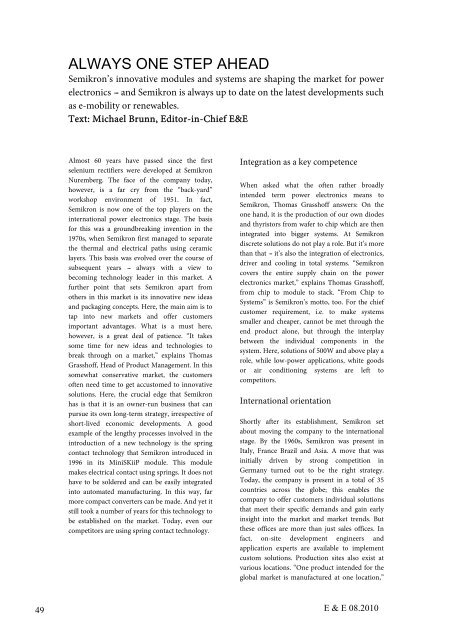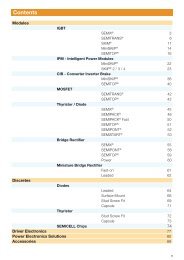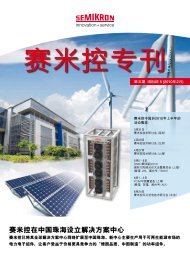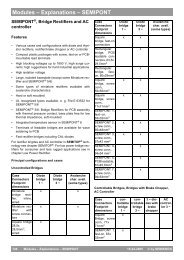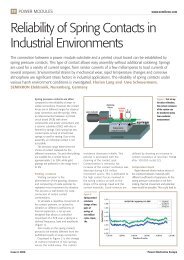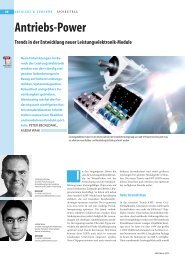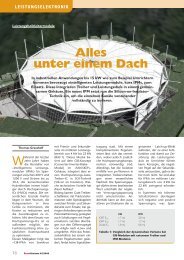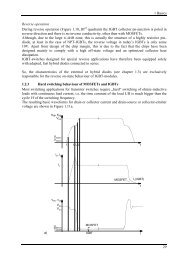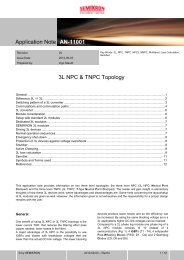Always one step ahead - Semikron
Always one step ahead - Semikron
Always one step ahead - Semikron
You also want an ePaper? Increase the reach of your titles
YUMPU automatically turns print PDFs into web optimized ePapers that Google loves.
ALWAYS ONE STEP AHEAD<br />
<strong>Semikron</strong>’s innovative modules and systems are shaping the market for power<br />
electronics -- and <strong>Semikron</strong> is always up to date on the latest developments such<br />
as e-mobility or renewables.<br />
Text: Michael Brunn, Editor-in-Chief E&E<br />
E&E 08.2010<br />
Almost 60 years have passed since the first<br />
selenium rectifiers were developed at <strong>Semikron</strong><br />
Nuremberg. The face of the company today,<br />
however, is a far cry from the ‘‘back-yard’’<br />
workshop environment of 1951. In fact,<br />
<strong>Semikron</strong> is now <strong>one</strong> of the top players on the<br />
international power electronics stage. The basis<br />
for this was a groundbreaking invention in the<br />
1970s, when <strong>Semikron</strong> first managed to separate<br />
the thermal and electrical paths using ceramic<br />
layers. This basis was evolved over the course of<br />
subsequent years -- always with a view to<br />
becoming technology leader in this market. A<br />
further point that sets <strong>Semikron</strong> apart from<br />
others in this market is its innovative new ideas<br />
and packaging concepts. Here, the main aim is to<br />
tap into new markets and offer customers<br />
important advantages. What is a must here,<br />
however, is a great deal of patience. ‘‘It takes<br />
some time for new ideas and technologies to<br />
break through on a market,’’ explains Thomas<br />
Grasshoff, Head of Product Management. In this<br />
somewhat conservative market, the customers<br />
often need time to get accustomed to innovative<br />
solutions. Here, the crucial edge that <strong>Semikron</strong><br />
has is that it is an owner-run business that can<br />
pursue its own long-term strategy, irrespective of<br />
short-lived economic developments. A good<br />
example of the lengthy processes involved in the<br />
introduction of a new technology is the spring<br />
contact technology that <strong>Semikron</strong> introduced in<br />
1996 in its MiniSKiiP module. This module<br />
makes electrical contact using springs. It does not<br />
have to be soldered and can be easily integrated<br />
into automated manufacturing. In this way, far<br />
more compact converters can be made. And yet it<br />
still took a number of years for this technology to<br />
be established on the market. Today, even our<br />
competitors are using spring contact technology.<br />
Integration as a key competence<br />
When asked what the often rather broadly<br />
intended term power electronics means to<br />
<strong>Semikron</strong>, Thomas Grasshoff answers: On the<br />
<strong>one</strong> hand, it is the production of our own diodes<br />
and thyristors from wafer to chip which are then<br />
integrated into bigger systems. At <strong>Semikron</strong><br />
discrete solutions do not play a role. But it’s more<br />
than that -- it’s also the integration of electronics,<br />
driver and cooling in total systems. ‘‘<strong>Semikron</strong><br />
covers the entire supply chain on the power<br />
electronics market,’’ explains Thomas Grasshoff,<br />
from chip to module to stack. ‘‘From Chip to<br />
Systems’’ is <strong>Semikron</strong>’s motto, too. For the chief<br />
customer requirement, i.e. to make systems<br />
smaller and cheaper, cannot be met through the<br />
end product al<strong>one</strong>, but through the interplay<br />
between the individual comp<strong>one</strong>nts in the<br />
system. Here, solutions of 500W and above play a<br />
role, while low-power applications, white goods<br />
or air conditioning systems are left to<br />
competitors.<br />
International orientation<br />
Shortly after its establishment, <strong>Semikron</strong> set<br />
about moving the company to the international<br />
stage. By the 1960s, <strong>Semikron</strong> was present in<br />
Italy, France Brazil and Asia. A move that was<br />
initially driven by strong competition in<br />
Germany turned out to be the right strategy.<br />
Today, the company is present in a total of 35<br />
countries across the globe; this enables the<br />
company to offer customers individual solutions<br />
that meet their specific demands and gain early<br />
insight into the market and market trends. But<br />
these offices are more than just sales offices. In<br />
fact, on-site development engineers and<br />
application experts are available to implement<br />
custom solutions. Production sites also exist at<br />
various locations. ‘‘One product intended for the<br />
global market is manufactured at <strong>one</strong> location,’’<br />
49<br />
E & E 08.2010


